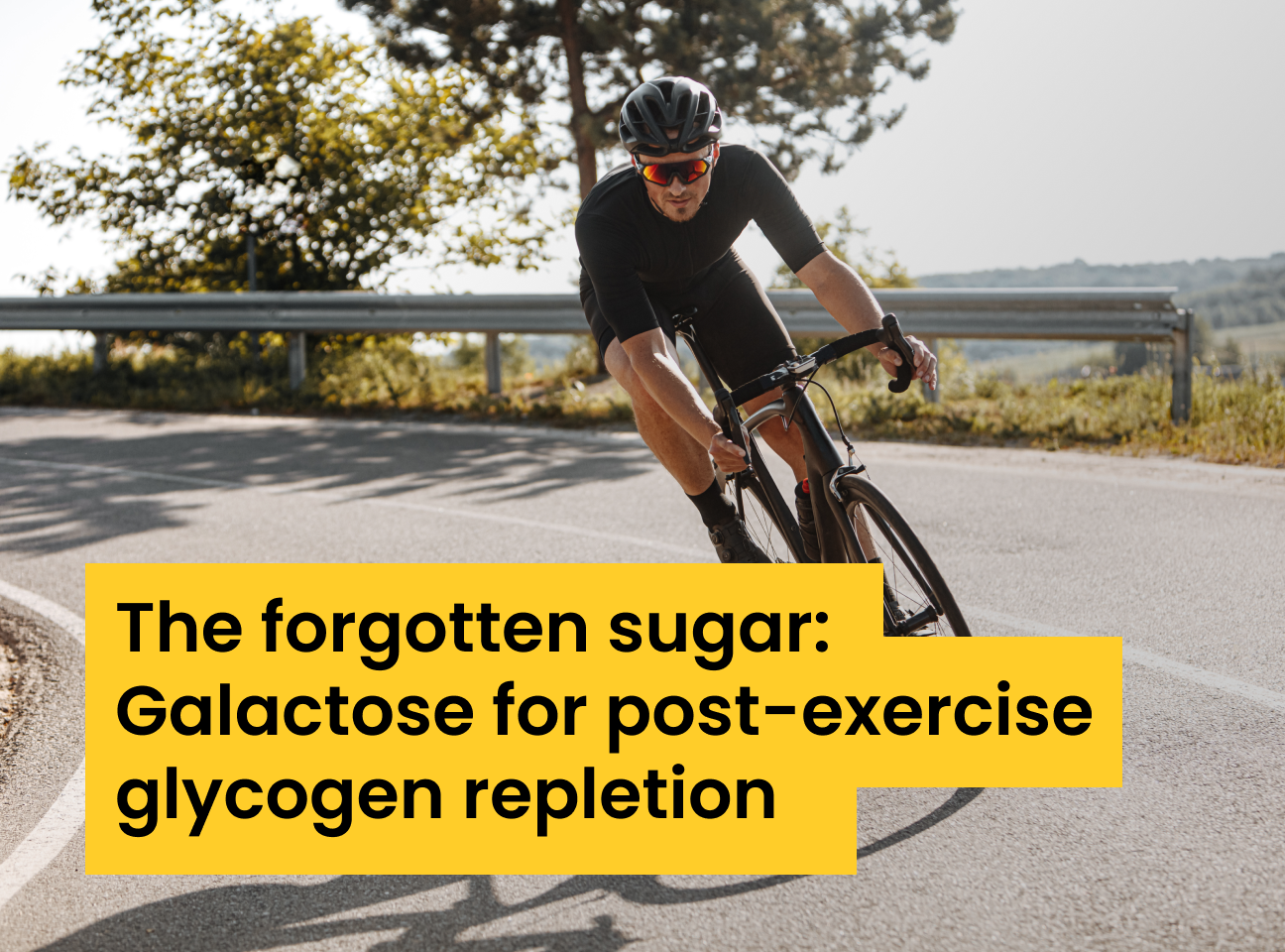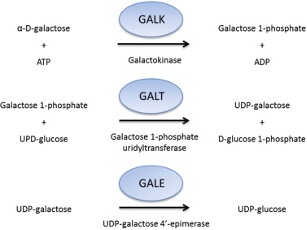
The forgotten sugar: Galactose for post-exercise glycogen repletion
By Dr. Mark Hearris

Research: Post-exercise muscle glycogen synthesis with glucose, galactose, and combined galactose-glucose ingestion by Podlogar et al (2023)
Introduction:
Following exhaustive exercise, both muscle and liver glycogen stores become depleted. In scenarios where recovery time is a precious commodity, priority should be placed on refuelling both storage sites. Consider these storage sites in the same way as a hybrid car – which has dual sites for energy storage, a fuel tank and an electric battery – both of which would require “filling up” after a long drive. In the same way the hybrid car uses different energy sources to fill both storage sites (e.g., petrol to fill the fuel tank and electricity to charge the battery), the body can use various energy sources (e.g., types of carbohydrate) to replenish glycogen in both the liver and muscle. As an example, glucose-based carbohydrates appear effective in restoring muscle glycogen but are less effective in restoring liver glycogen compared to other sugars such as fructose and galactose (Gonzalez et al., 2017). Why? This is thought to be because the muscle lacks the required apparatus to metabolise these sugars and so they are preferentially metabolised within the liver. This is typically why glucose and fructose mixtures are often used as an effective strategy to replenish both storage sites over single sugars alone. Although various combinations of sugars have been studied, galactose (one of the sugars found within lactose) has received little attention, with its effect on muscle glycogen resynthesis yet to be investigated.
The study:
Nine participants (including two female participants) completed this randomised, repeated measures, cross-over design, performing three different experimental trials in a randomised order. Whilst subjects participated in regular endurance exercise, they would likely be classified as Tier 1 exercisers (recreationally active) using the recent classification framework by McKay and colleagues (McKay et al., 2022) given their 51.1 ± 8.7 ml/kg BM VO2max and 330 W maximum power. On each visit, subjects completed a well-established glycogen-depleting cycling protocol followed by a four-hour recovery period to determine rates of glycogen resynthesis in response to different sugar combinations. Participants consumed a carbohydrate intake of 1.2 g/kg of body mass (BM) per hour – a rate of intake that is often considered as the upper limit to promote muscle glycogen repletion (ref). Recovery drinks were formulated with either 1) glucose, 2) galactose or 3) a combination of both galactose and glucose in a 2:1 ratio and were consumed at regular 30-minute intervals throughout the recovery period. Muscle biopsies were collected immediately post-exercise and after 4 hours of recovery to measure glycogen concentrations. Moreover, the researchers measured the expression of key enzymes involved in the Leloir pathway (see below) to determine whether skeletal muscle has the capacity of directly metabolising galactose.
A closer look: The Leloir pathway
Named after the Nobel Prize winning biochemist Luis Leloir, the Leloir pathway, is the main pathway for the metabolism of galactose within the body and has been thought to occur exclusively within the liver. This pathway results in the production of glucose 1-phosphate which can enter glycolysis (where it can be ultimately oxidised to produce ATP) or be stored as glycogen via glycogenesis. To achieve this, galactose is firstly phosphorylated (a phosphate molecule is attached) to become galactose 1-phosphate via the enzyme galactokinase (GALK). Next, the enzyme galactose 1-phosphate uridyltransferase (GALT) converts galactose 1-phosphate to UDP-galactose which is finally converted to UDP-glucose via the enzyme UDP galactose-4′-epimerase (GALE). UDP-glucose can enter the glycogenesis pathway to be stored as glycogen or be converted to glucose 6-phosphate and enter glycolysis to produce ATP.
Findings:
Following the glycogen depleting exercise, muscle glycogen was depleted to approximately 200 mmol.kg-1 dry weight (dw) across each of the three trials which represents a 60% depletion from typical resting values. Throughout the recovery period, the consumption of galactose failed to increase either glucose or insulin concentrations within the circulation (two important factors which drive glycogen synthesis), when compared with the glucose only and combined galactose/glucose mixtures. This suggests that it is unlikely that any of the galactose that was potentially being converted to glucose within the liver was being released back into the circulation where it could be taken up by the muscle and stored as glycogen. After four hours of recovery, the glucose solution had increased muscle glycogen by 163 mmol.kg-1 dw (~81% increase) which represented a significantly larger increase when compared to the galactose only (+ 114 mmol.kg-1 dw) and combined galactose and glucose mixture (+ 117 mmol.kg-1 dw), which displayed almost identical resynthesis of glycogen (~57% increase). From the biopsy samples, the researchers were also able to demonstrate that key enzymes involved in the Leloir pathway (GALK and GALT) are present within skeletal muscle, which suggests that the muscle can directly metabolise galactose as an energy source as opposed to it being exclusively metabolised within the liver.
Relevance:
From a practitioner’s point of view, these data show us that galactose is a suboptimal sugar to promote rapid repletion of muscle glycogen after exhaustive exercise, whether used in isolation or when combined with glucose in a 2:1 ratio. With that said, questions remain about its effectiveness in repleting liver glycogen given the liver appears to be the preferential site of metabolism. Given the lack of change in blood glucose concentrations with galactose ingestion throughout recovery, it appears that if galactose is being metabolised within the liver (where it is converted to glucose), this glucose is potentially being stored as liver glycogen as opposed to being released back into the circulation where it can become available to the muscle tissue. In support of this prediction, one previous study demonstrated higher rates of liver glycogen resynthesis with the addition of galactose (to maltodextrin) when compared with glucose (Décombaz et al., 2011). Despite the clear practical implications of this data for muscle glycogen repletion, the finding that skeletal muscle appears to possess the ability to directly metabolise galactose (given enzymes involved in the Leloir pathway were expressed in the biopsy samples) leaves us with many new questions to answer.
Complement this research with the We Do Science podcast episode: Carbohydrates with Prof James Morton
References:
Décombaz, J., Jentjens, R., Ith, M., Scheurer, E., Buehler, T., Jeukendrup, A., & Boesch, C. (2011, Oct). Fructose and galactose enhance postexercise human liver glycogen synthesis. Med Sci Sports Exerc, 43(10), 1964-1971. https://doi.org/10.1249/MSS.0b013e318218ca5a
Gonzalez, J. T., Fuchs, C. J., Betts, J. A., & van Loon, L. J. (2017, Mar 30). Glucose Plus Fructose Ingestion for Post-Exercise Recovery-Greater than the Sum of Its Parts? Nutrients, 9(4). https://doi.org/10.3390/nu9040344
McKay, A. K. A., Stellingwerff, T., Smith, E. S., Martin, D. T., Mujika, I., Goosey-Tolfrey, V. L., Sheppard, J., & Burke, L. M. (2022, Feb 1). Defining Training and Performance Caliber: A Participant Classification Framework. Int J Sports Physiol Perform, 17(2), 317-331. https://doi.org/10.1123/ijspp.2021-0451

